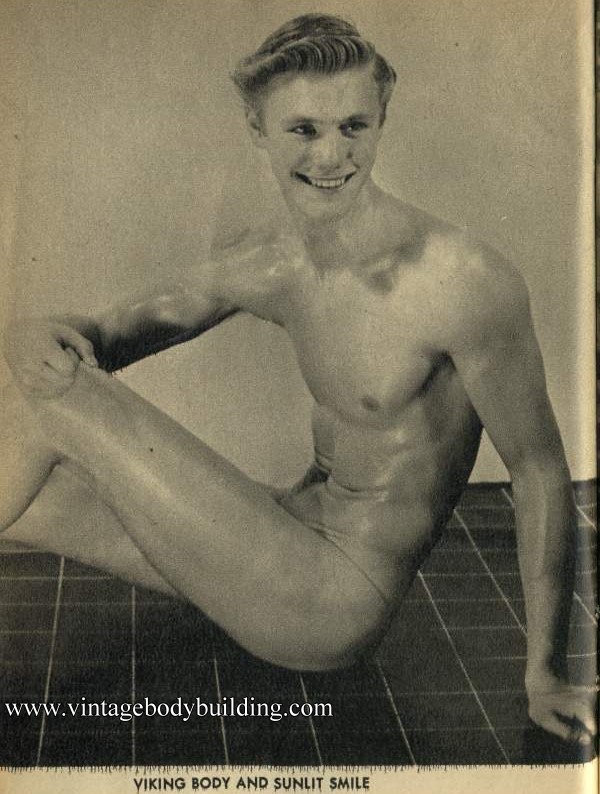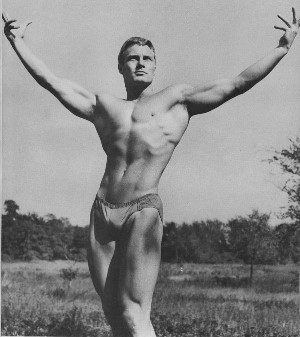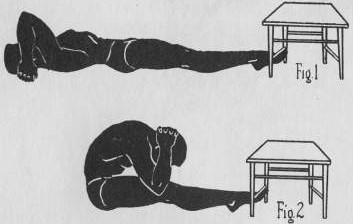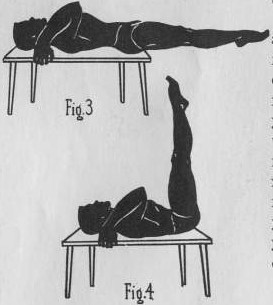Viking boy and sunlit smile – Gary Frost from Body Beautiful Volume 3 N 3 of 1957

Viking boy and sunlit smile – Gary Frost from Body Beautiful Volume 3 N 3 of 1957

YOUR GREAT BREATHING MUSCLE
by Joseph E. Weider
Editor-in-Chief and Publisher
Do you know the natural way to breathe? Where are your great breathing muscles located? How can they be strengthened and of what benefit can they mean to you? An enlightened article that should be read and practiced by everyone.

As you of course know, the diaphragm is the floor of the chest, separating the heart and lungs above from the stomach and liver below it; it is the partition between the thoracic and abdominal cavities.
We breathe in two ways: by raising the ribs and holding the diaphragm still, or secondly, by lowering the diaphragm while the ribs remain stationary. Of course, these methods may be combined, and most people really do blend them more or less.
When muscularly exerting ourselves we need all the air available, and we instinctively secure it by breathing deeply both ways. But, by far the greater portion of time is spent in comparative repose; so the manner of breathing during these hours must be highly important.
Diaphragmatic breathing — permitting the ribs to remain virtually stationary while we contract and relax the diaphragm — is the proper method for repose, and this is proved by several facts. The descent of the diaphragm gently massages all the organs below it, improving the digestive and eliminative functions. Habitual chest breathing leaves the abdominal organs inert, except when they are stirred by vigorous bodily exercise. Secondly, the absorption of oxygen from a given volume of air is greater when it is breathed diaphragmatically than when the chest method is used. Thirdly, breathing with “the floor of the chest” means a considerable economy of muscular energy, because to raise the ribs involves some of the body’s largest muscles.
But with the average person, the diaphragm grows weaker after the first few years of childhood. Unhealthful habits, tight clothing, and especially careless, stooping posture in walking and sitting, cramp the great breathing muscle. From inactivity, it finally loses nearly all of its involuntary action, moving only by an effort of our will. Many persons lose control of it entirely, and many suffer for years from various organic complaints as a result. One of the finest things any boy or girl could do for his or her health and strength is to guard against loss of the
diaphragm’s natural action, as he or she grows older.

Test yourself now. Stand erect, hands on front and sides of upper chest, fingers spread. Now take an ordinary breath and see where the expansion occurs. If you feel the ribs rise and your waistline remains unmoved, your breathing is chest respiration. If the ribs hold their place and the abdomen expands, you are breathing diaphragmatically — properly for all times except when exercising.
Sometimes a person, in trying to breathe diaphragmatically, will contract the abdominal muscles and mistake their expansion for the result of the diaphragm’s descent. Guard against that; the muscles must remain relaxed so that the diaphragm may descend easily. Its ascent is simply a matter of its own muscular relaxation between the downward movements. Practice persistently, always keeping your mind on the exercise. Every week’s work will show results, till the habit is formed.
I have known diaphragms to be so weak that no amount of effort while the person was standing would bring them under voluntary control. In such cases one must lie down. Reclining on the back makes diaphragmatic breathing far easier, and by keeping the hands on the chest walls one can tell very accurately how he is coming on.
Breathe slowly, letting inhalation and exhalation occupy about the same length of time. Never hold your breath for more than a few seconds. At first you should not try to breathe very deeply; for your diaphragmatic capacity may be small for several weeks, and a too forceful inspiration will shift you into the chest method.
Waisting Away
 A soft, flabby, unmuscular waistline ruins the appearance of many a guy who otherwise might be admired for his physique. Perhaps more than any other feature of the body, the waist is the barometer of physical condition. The average man who loves his coffee with cream, his pie, and his beer, sooner or later finds himself spreading in the mid-section. Exercise alone probably won’t keep that trim youthful waist for you. Eating is important, too. But assuming one goes easy on foods which tend to build up fatty tissue (often first deposited in the form of an unsightly paunch), exercise can help maintain or achieve a trim, muscular waist.
A soft, flabby, unmuscular waistline ruins the appearance of many a guy who otherwise might be admired for his physique. Perhaps more than any other feature of the body, the waist is the barometer of physical condition. The average man who loves his coffee with cream, his pie, and his beer, sooner or later finds himself spreading in the mid-section. Exercise alone probably won’t keep that trim youthful waist for you. Eating is important, too. But assuming one goes easy on foods which tend to build up fatty tissue (often first deposited in the form of an unsightly paunch), exercise can help maintain or achieve a trim, muscular waist.
 Whether you use weights or not, ‘along with your push-ups you can easily do sit-ups and leg raises. They’re doubtless the most effective exercise for keeping down the waistline. And you don’t need a gym for this kind of work-out. Sit-ups can easily be performed on a chair placed sideways next to a bed or some heavy piece of furniture under which you can anchor your feet. (See Fig. 1 & 2). Then, with your hands behind your head, you can go to it! If you have a tendency to spread, at least three sets of not less than fifteen repetitions should be performed every other day.
Whether you use weights or not, ‘along with your push-ups you can easily do sit-ups and leg raises. They’re doubtless the most effective exercise for keeping down the waistline. And you don’t need a gym for this kind of work-out. Sit-ups can easily be performed on a chair placed sideways next to a bed or some heavy piece of furniture under which you can anchor your feet. (See Fig. 1 & 2). Then, with your hands behind your head, you can go to it! If you have a tendency to spread, at least three sets of not less than fifteen repetitions should be performed every other day.
Leg raises can just as easily be done at home. Place your hands behind your head and grasp the bed springs .or table top) for support. (See Fig. 3 & 4). And then raise away! Use the same number of reps and sets as with sit-ups.
Better watch your waist! Once it has spread, it’s no easy job to trim it down.
American Apollo Volume 1 № 1, May 1958.
Publisher: New World Enterprises Syndicate
Jim Stryker sculptural model, in “Bow and Arrow Hunter …Gets Ready!”.

The Deep Knee – Bend

This is one of the most beneficial of all exercises and should be a part of every bodybuilder’s exercise program. Begin the deep knee-bend by standing erect, hands on hips and feet a comfortable distance apart (Position #1). For better balance, place your heels on a book or block of wood an inch or two thick. Inhale. Then, keeping your back perfectly straight, lower your body-to a squatting position until your buttocks touch your heels (Position #2). Pause and exhale. Then return to the starting position. Do at least twelve repetitions.
Variations on the basic exercise can be undertaken as you progress. Try it, for instance, with your feet flat on the floor and close together. Or use a weight either placed across your shoulders or held in each hand.
One of the most beneficial variations of the deep knee-bend is to perform it squatting on one leg at a time, with the other leg held straight out in front of you. At first you will probably need to hold onto some stationary object like a chair, bed or dresser. In time you will learn to keep your balance without holding on to anything. Try it with your arms stretched out straight in front as you go into Position #2, returning your hands to your hips as you regain Position #1. After you’re good at this, you can hold a weight in each hand for more muscle-building strain.
The deep knee-bend is especially good for the upper leg region. It develops the Vastus Externus (the long muscle that runs along the outside of the upper leg) and the Vastus Internus (the muscle situated at the front and inside of the leg just above the knee). It also aids in the development of the Gluteus Maximus (the buttocks muscles) and broadens the chest as a result of the deep breathing it requires.
Learn the basic exercise thoroughly first, then try the variations. You’re only as good as your legs — and the deep knee-bend will give you strong, well-proportioned ones.
Future Man Volume 1 № 1, Winter 1962
Publisher: Physique Press
AMERICAN APOLLO
Vol. I №4
A “Physique Press” Publication
Owing to that old cliche, “circumstances beyond our control, ” the 3rd issue of A.A. was horribly fated. So please do not request it, when ordering any back numbers. Numbers One and Two though are still available in limited quantity.
The welcome news is that A.A. will now be on a regular quarterly schedule and is one of a family of twelve outstanding and individually different publications in the physique-and-health field.. The titles in the Physique Press group:
American Apollo; Samson; Physiques Speak; Manhattan Man; Trojan; Olympians; Thor; Young Man; Goliath; Jason; The Argonauts;’ Gladiator.
Being that Physique Press will be dedicated to bringing something entirely new and refreshing into the physique and health field, readers will learn that each of our titles is individual by itself. Whether it’s humor or something on the more serious side, or an occasional blending of various ingredients (as in this issue of A.A.), there is something for everyone!
